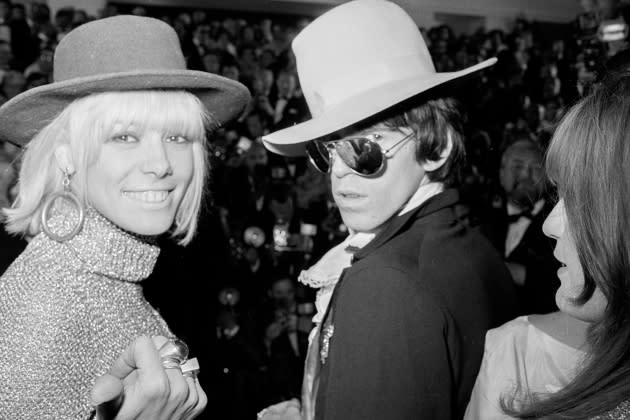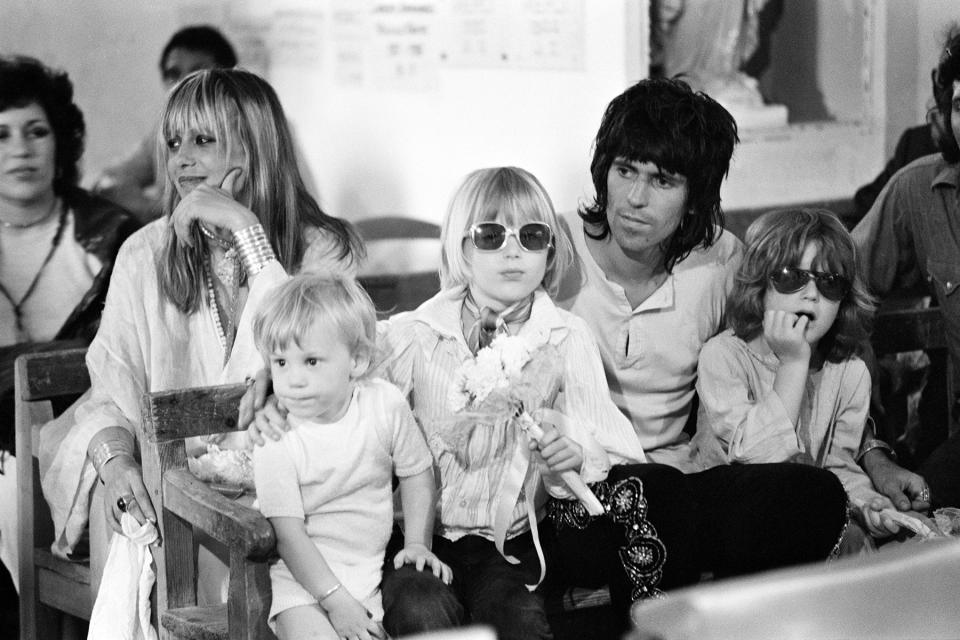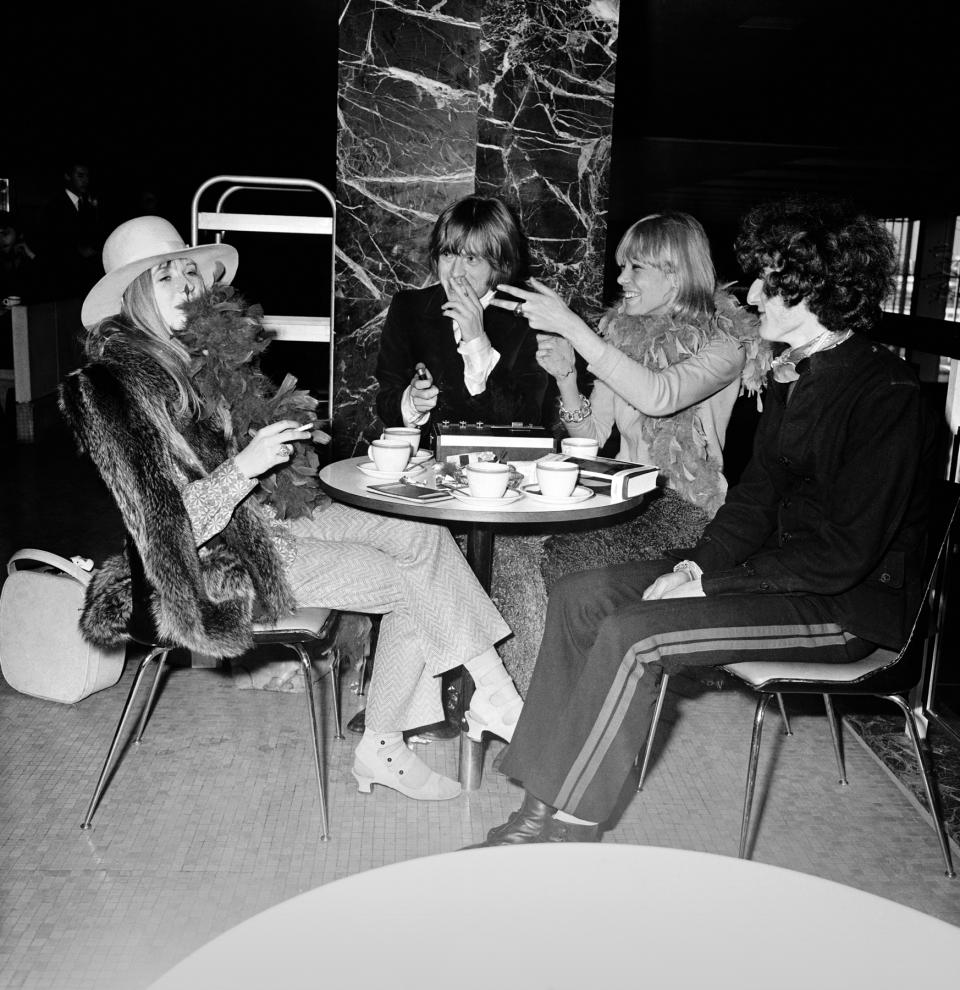How Anita Pallenberg Transformed the Rolling Stones From ‘Schoolboys’ to Stars
- Oops!Something went wrong.Please try again later.
- Oops!Something went wrong.Please try again later.
- Oops!Something went wrong.Please try again later.

The Rolling Stones have existed for six decades, yet the women who influenced the members and their music have been largely overlooked and under-appreciated. But with her new book Parachute Women: Marianne Faithfull, Marsha Hunt, Bianca Jagger, Anita Pallenberg, and the Women Behind the Rolling Stones, Elizabeth Winder is attempting to change that. In an excerpt below, Winder details the moment Anita Pallenberg’s path crossed with the band — and how she transformed them from “schoolboys” to stars.
***
September 14, 1965, Munich, Circus Krone Bau. You could tell she was different from the other Stones groupies, in her beige fur jacket, skintight sweater, and Ossie Clark mini. She looked nothing like Carnaby Street’s trendy dolly birds with their knee socks and baby-doll dresses, their saucer stares of white liner, gobs of mascara, and strips of Glorene. Everything about her suggested experience, from her hard-to-place accent to the gladiator sandals she’d had handmade in Rome. She was overtly sensual — sexual even — but exuded an almost masculine energy. Even Mick was intimidated by this German Italian actress, who pounced backstage with the stealth of a cat. Was she just another fangirl or Jack the Ripper in disguise?
More from Rolling Stone
Revisit The Rolling Stones Infamous 1972 North American Tour on New Podcast
Lace Me Up: Skechers Drops New Limited-Edition The Rolling Stones Sneaker Collection
She hovered in the door of the dressing room, her gaze sharp, her smile cocky, revealing flashes of fang-like teeth. She dug around her pockets for a vial of amyl nitrate. “Vant to smoke a joint?” Mick and Keith eyed her suspiciously. They’d never done drugs before — the only coke they had was mixed with rum. She glanced at Brian. “Yeah, let’s smoke a joint,” he said, eyes filled with tears. “Come back to the hotel.” They returned to his room to smoke and talk for hours, and he spent the night weeping in her arms.
Anita followed the Stones to Berlin the next day. Tours were strictly girlfriend-free zones, and here Brian was flaunting his bewitching new lover. He was breaking all his rules, and he’d only known her a day.
Compared to Anita, the Stones were grubby adolescents, awkward and hopelessly naive. London wasn’t quite swinging yet, and British rock was barely emerging from its gawky teen phase. Anita was “cosmopolitan beyond anyone’s imagination” and catnip to young rockers who craved the aura of experience. It was clear she’d lived many lives — skipping school with the street kids and artists in Rome, grave digging, beach drinking, boyfriends with Vespas, Café Rosati with Federico Fellini — “all that Dolce Vita stuff.” She’d lived in Warhol’s Manhattan as a Factory girl; she’d danced on tables at Regine’s in diaphanous gowns. Whatever you’d experienced, she’d already done it a thousand times.
Mick stared at her with lustful awe, Keith admired her from a distance. “The first time I saw Anita my obvious reaction was, ‘What the fuck is a chick like that doing with Brian?’”
It wasn’t that they were intimidated by her model status. Mick and Keith were both dating models — English ingenue types with no runs in their stockings and long-lashed doe-eyed stares. But Anita was a different breed entirely. She’d been one of Catherine Harlé’s models in Paris — a champagne-popping modeling agent known for rebellious It Girls with rock & roll connections. Half eighteenth-century salon, half Warholian Factory, Harlé’s agency in Place des Vosges didn’t churn out your typical mid-century models. Harlé’s girls included Snowqueen of Texas Deborah Dixon, hippie icon Talitha Getty, Dalí muse Amanda Lear, and Teutonic rock goddess Nico. They stormed down Rue de Turenne like granny-booted gladiators, with men like Bob Dylan, Jim Morrison, and Brian Jones trailing helplessly in their wake.

These girls were miles apart from the dolly birds and English roses across the channel. The Twiggys, Patties, Chrissies, and Jeanies, so popular in London, remained in the shadow of their male counterparts. They earned their own money, lived in their own flats, and enjoyed more freedoms than their mothers had done. But they didn’t cleave from the roles society molded for them, nor did they challenge their male peers.
Harlé’s models didn’t just challenge society — they laughed in its face. No milk baths or 10 p.m. bedtimes for them. “They behaved like men,” wrote Parisian journalist Fabrice Gaignault.
“They were so important for the culture of the time. They were a little frightening for the Parisian male, because Parisian men were bourgeoisie, and they were nothing like that. They were free, stronger than men.” Pop singer Jacques Dutronc even wrote a song about them, “those who know how to speak to the models of Catherine Harlé.”
These were women who made a living out of terrorizing men, and Anita was at their helm. She partied harder, drank more, danced more, smoked more than any of the men around her. “We were out every night,” recalled Deborah Dixon. “Of course, we were smoking dope — they were wild days — but we were having a lot of fun. In those days, especially in London, the girls were all wishy-washy — we were completely the opposite. Anita was different. She set up sort of an aggressive look. A look that said she was not just going to be a doll.”

Nor would she submit to the macho celebrity photographers. She stopped their bravado dead in its tracks, ripping off her lash strips, smudging black liner with her thumb, bitching about the hot stage lights and the thick cold cream assistants used to clean her face. She sometimes blew off gigs entirely, instead made her name on the dance floors of Maxim’s, Regine’s, and Chez Castel (always slipping in the side door for free). She wore undereye circles like a badge of honor and sneered at models who “went to bed at nine, wearing eye masks.”
Brian prided himself on being the only Stone brave enough to take Anita on. (He was, at this point, “the only Stone who inhaled.”) “They were still schoolboys,” Anita said of Mick and Keith. “Brian was acting on it faster than anyone else — he knew his stuff very well.” But Brian — the band’s self-proclaimed leader — was also the Stones’ most vulnerable member. Mick and Keith had bullied him for years, and Anita walked into this fractured dynamic.
Of all the sexist cultural myths floating around, women as gossips might be the worst. Mick was the emperor of gossip and bitchery — setting the tone for childish power struggles from the band’s very inception. Three years in and they were still at it — classic playground lunch-table snubbery — with Brian as the target. “Mick and I were incredibly cruel to Brian,” Keith wrote years later. “I used to do this vicious impression of Brian. It was all funny, but incredibly cruel, and people just used to roll up laughing. It was a period that was really bitter, very nasty — not for Mick and I particularly, but for Brian.”
Emotions embarrassed the repressed English Mick and Keith. Anita was attracted to Brian’s emotional intelligence. His delicate looks appealed to her too, the way he straddled masculine and feminine. Sharp cheekbones, Pan-like movements that were more fey than androgynous. “Sexually I like girls as well as men,” Anita explained, “and Brian seemed to combine both sexes for me at the same time.” Despite his insecurities, Brian was remarkably comfortable with his sexual identity. Mick and Keith were still trapped in mid-century gender norms and fifties homophobia.
At a time when women were expected to be earth angels, Anita was sexually brash — propositioning John Phillips of the Mamas and the Papas (it was really an excuse to hitch a ride to Tangier), sending Jeff Beck notes in the middle of the night. She was nonchalantly bisexual. (Anita: “Everyone does it in Italian summers.”)

Men of course were allowed their peccadillos — especially rock stars with all their proverbial fans and groupies. But for the Stones in ’65 this was mostly male bluster. Mick and Keith had barely slept with anyone. Only Brian was sexually experienced. “Brian was so far ahead of them you wouldn’t believe it,” Anita recalled to David Dalton. “He had chicks. All the chicks. And he used to fuck everybody else’s chick. I mean, he knew it, he really had it down and they didn’t. Here are Mick and Keith up onstage trying to learn how to be sex objects, and Brian already had a string of illegitimate children! Except for Brian all the Stones at that time were really suburban squares.”
Brian was the real deal. Mick kept a bottle of Scotch rattling in the back of his car, but it was really just for show. By the time he met Anita, Brian was consuming two bottles a day. In fact, he usually stunk of brandy — he’d read somewhere that jazz musicians used it as a food substitute.
Alcohol exacerbated Brian’s fragile disposition — leading to tantrums, meltdowns, car crashes, and crying jags. But that didn’t bother Anita. She liked Brian’s mercurial nature — moody was better than boring in her book. He’d quickly shake off the doom and snap back to his jaunty self. In those days his curiosity was stronger than his self-destructive impulse.
They both shared a natural curiosity and innate receptiveness — qualities that formed the backbone of their relationship. “He had a wonderful curiosity,” remembered Anita. “Curious about new things, new places. He wanted to know everything that was going on, wanted to meet new people, new ideas, learn the new dances; the other Stones were more like frightened. Brian was much more ready to go to strange places to meet people he didn’t know. Not like Keith, who in those days sort of sneered at anybody who tried to get too close to him.”
For now, Keith and Mick regarded her with suspicion. (“You could see them exchanging looks like who’s this weird bird?”) Years later they would realize that Anita was the magic ingredient, the secret to their success.
Excerpted from PARACHUTE WOMEN: Marianne Faithfull, Marsha Hunt, Bianca Jagger, Anita Pallenberg, and the Women Behind the Rolling Stones by Elizabeth Winder. Copyright © 2023. Available from Hachette Books, an imprint of Hachette Book Group, Inc.

